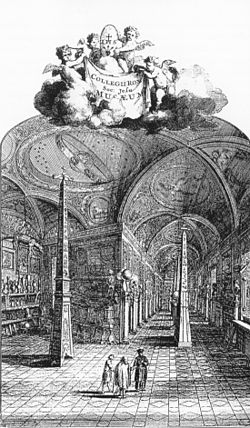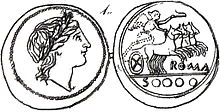Kircherian Museum
Museo kircheriano | |
 The Kircherian Museum in 1679 | |
 | |
| Established | 1651 |
|---|---|
| Dissolved | 1916 |
| Location | Piazza del Collegio Romano 4, Rome |
| Coordinates | 41°53′56″N12°29′04″E/ 41.8989°N 12.4845°E |
| Type | Archaeology,science,andtechnologymuseum |
| Founder | Athanasius Kircher |
TheKircherian Museumwas a public collection of antiquities and artifacts, acabinet of curiosities,founded in 1651 by the Jesuit fatherAthanasius Kircherin theRoman College.Considered the first museum in the world, its collections were gradually dispersed over the centuries under different curatorships. After theUnification of Italy,the museum was dissolved in 1916 and its collection was granted to various other Roman and regional museums.
History
[edit]In 1651, Italian aristocrat and antiquarianAlfonso Donninidonated his "cabinet of curiosities"to the members of the Roman College. The collection contained" various curious and precious things so that they can take care of it and their studies may benefit from it. "FatherAthanasius Kircher(1602–1680), professor of mathematics, physics, and oriental languages, took care of the collection and transformed it into a museum of antiquity, technology, art, science, and archeology.
Famous and admired by the most enlightened minds of his time and by his students at the Roman College for his scientific knowledge and philosophical eclecticism, Kircher added natural history objects collected during his expeditions to Sicily (1630) and Malta (1636), musical instruments, and even machines of his own invention. He used his contacts, particularly Jesuits abroad, to augment ethnographic collections with exotic objects from overseasmissions.

The museum quickly became popular and hosted many visitors. The first catalog was published in 1678 by Giorgio de Sepibus and included some illustrated tables, today the only evidence of the museun's layout. After Kircher's death in 1680, the museum went through a period of neglect. It took on new life and vigor thanks to the activity of the new curatorFilippo Bonanniwho published a second catalog in 1709. By comparing the two catalogs, it is clear that many objects had already disappeared from the collection. Over time the museum regained its former glory and thanks to the aid received and the many donations, it became the seat of many important collections on fields of knowledge from experimental philosophy to esotericism to technology. FathersOrazio Borgondio(1725-1741),Contuccio Contucci(1741-1761) andAntonio Maria Ambrogi(1761-1772) succeeded Bonanni as curators; during this period the Marquis Alessandro Gregorio Capponi and KingAugust of Polandadded their donations to the museum.[1]The archaeology collection was expanded by the Jesuit Contuccio Contucci, director of the museum between 1741 and 1761.[2]
Dispersement
[edit]The last Jesuit director of the Museum was the scholar Antonio Maria Ambrogi (1713–1788). In 1773, following theSuppression of the JesuitsbyClement XIV,the Roman College was entrusted to the clergy of Rome and the collections began to undergo drastic alterations: many finds ended up in thePio-Clementino Museumin the Vatican Museums. In 1814, theSociety of Jesuswas reconstituted byPius VII,and in 1824,Leo XIIreturned the college and museum to the Jesuits. From 1839 and for almost twenty years, the museum was directed byGiuseppe Marchi.Marchi attempted a reorganization of the collection and produced a monograph on the ancient coins preserved there, theAes grave del Museo Kircheriano.

When Rome was conquered in 1870 and became the capital of theKingdom of Italy,most of the ecclesiastical properties were expropriated by the new, unified state. TheEnnio Quirino Visconti Liceo Ginnasioand theBiblioteca Nazionale Centrale di Romawere placed in the Roman College. The Kircherian Museum also became a state museum and between 1881 and 1913 was directed byLuigi Pigorini,who increased its collections by joining thePigorini National Museum of Prehistory and Ethnographyto it.[3]
In 1913, a decree of the Ministry of Education authorized the definitive dispersion of the collections,[4]which were distributed in the new state museums of the capital. The Etruscan and Italic antiquities went to theNational Etruscan Museum,the Roman ones to theNational Roman Museum,the medieval and Renaissance to theCastel Sant'Angeloand, in 1916, the newMuseo nazionale del Palazzo di Venezia.Some curiosities, such as the wooden models of the Roman obelisks, remained at the college; thePigorini National Museum of Prehistory and Ethnographywas finally transferred to Roman neighborhood ofEuropain the 1960s.
Legacy
[edit]An exhibition dedicated the Kircherian museum was held in Rome at thePalazzo Veneziain 2001. The ItalianMinistero della Culturapublished a catalog with photos of objects in the Kircher collection that had been dispersed to other institutions. In recent years, the teachers and pupils of the Liceo Visconti have prepared a museum layout that recalls the historic Kircherian museum.[5]
See also
[edit]References
[edit]- ^Findlen 1995,p. 659.
- ^"La raccolta del Museo Kircheriano".Archived fromthe originalon 30 July 2018.
- ^Cfr."Il Museo Nazionale Preistorico Etnografico di Luigi Pigorini"(PDF).iipp.it.Retrieved20 October2020.
- ^Ottavio Cicchinelli (30 January 2017)."Athanasio Kircher in Italia"(in Italian).Retrieved20 October2020.
- ^Cfr."Wunder Musaeum".wundermusaeum.com.Retrieved8 September2020.
Bibliography
[edit]- Encyclopedism in Baroque Rome: Athanasius Kircher and the Museo del Collegio Romano between Wunderkammer and the scientific museum, curated by Maristella Casciato. Venice, Marsilio 1986.ISBN88-317-4846-7
- Findlen, Paula(1995). "Scientific spectacle in Baroque Rome: Athanasius Kircher and the Roman College Museum".Roma Moderna e Contemporanea.III(3): 625–665.
- Athanasius Kircher - the museum of the world [Rome, Palazzo di Venezia, February 28 - April 22, 2001], Ministry for Cultural Heritage and Activities, Central Office for Archival Heritage. Curated by Eugenio Lo Sardo. Rome, De Luca 2001.ISBN88-8016-421-X,ISBN88-8016-409-0
- Claudia Cerchiai (edited by), The Roman College from its origins to the Ministry for Cultural Heritage and Activities, Rome, 2003.
- Alberto Bartòla, «At the origins of the Roman College museum. Documents and testimonies ", in Nuncius, 1, 2004, pp. 297–356.
- Angela Mayer-Deutsch, Das Museum Kircherianum. Kontemplative Momente, historische Rekonstruktion, Bildrhetorik, Zürich, 2010.
- Nathalie Lallemand-Buyssens, «The acquisitions of Athanasius Kircher in the museum of the Romain Collège à la lumière de documents inédits», in History of Art, n. 133, Oct-Dec 2012, pp. 107–129.
- Filippo Bonanni(1709).Musaeum Kircherianum(in Latin). Roma.
{{cite book}}:Unknown parameter|agency=ignored (help)
